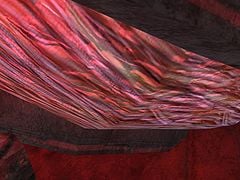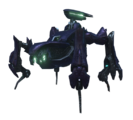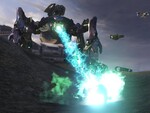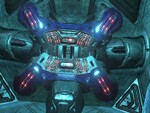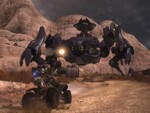Deutoros-pattern Scarab: Difference between revisions
From Halopedia, the Halo wiki
m (→Design: grammar error) |
m (→Halo Wars) |
||
| Line 97: | Line 97: | ||
The Scarabs excel at attacking vehicles and infantry with their powerful weapons, though aircraft take longer for the Scarab to take down. Scarabs are very mobile, being able to climb over most obstacles. Only certain obstructions, like craters or fire, can block them. In the campaign level ''Beachhead'', the player may use a [[SPARTAN-II Program|Spartan]] to commandeer an abandoned Scarab. Commandeering this Scarab and using it to destroy twenty-five enemy units unlocks the achievement [[Beaming with Pride]]. | The Scarabs excel at attacking vehicles and infantry with their powerful weapons, though aircraft take longer for the Scarab to take down. Scarabs are very mobile, being able to climb over most obstacles. Only certain obstructions, like craters or fire, can block them. In the campaign level ''Beachhead'', the player may use a [[SPARTAN-II Program|Spartan]] to commandeer an abandoned Scarab. Commandeering this Scarab and using it to destroy twenty-five enemy units unlocks the achievement [[Beaming with Pride]]. | ||
Scarabs are extremely difficult to destroy. Overwhelming it with a massive attack force works well, particularly when using anti-vehicle units like the [[Special Purpose-42 Main Battle Tank]] | Scarabs are extremely difficult to destroy. Overwhelming it with a massive attack force works well, particularly when using anti-vehicle units like the [[Special Purpose-42 Main Battle Tank]] or some [[Hunters]], but a significant portion of the attack force will be lost in the process. An upgraded [[Magnetic Accelerator Cannon#Halo Wars gameplay|MAC blast]] or [[carpet bomb]] can destroy a Scarab rather quickly, as can a group of [[AC-220 Vulture]]s using their missile barrages. Covenant leader units' special abilities can inflict massive damage on a Scarab, with the [[Prophet of Regret]]'s cleansing beam being a good example. | ||
Winning a Skirmish game with two Scarabs unlocks the [[2 Bugs Are Better Than 1]] achievement | Winning a Skirmish game with two Scarabs unlocks the [[2 Bugs Are Better Than 1]] achievement | ||
Revision as of 10:04, August 10, 2011
- "We've all run the simulations. They're tough, but they ain't invincible!"
- — Sergeant Major Avery Johnson[1]
The Type-47 Ultra Heavy Assault Platform, more commonly known as the Scarab, is a Covenant mobile mining platform adapted for use in combat. It is used to attack heavily defended structures and emplacements and to provide nigh-unstoppable combat support to Covenant ground forces.[2][3]
Design
At least two models of the Scarab exist: the V1 and the V2.[3] Both models are extremely powerful, possessing potent armament and armor. Although the Scarab appears to be a traditional vehicle, it is actually a biological construct, a Mgalekgolo, that is controlled by thousands of Lekgolo "eels". The chassis is built around the eels and a critical central core in specialized facilities, such as the Assembly Forges on the now-destroyed Covenant capital High Charity. The Lekgolo are quite capable of maneuvering the construct on their own; however, each platform includes a pilot who "guides" the Scarab and several warriors who are stationed to repel boarders and, with the V2, to operate its deck-mounted plasma cannons.[2]
Despite its enormous strength, the Scarab is quite vulnerable to being boarded; the platform's central core is protected only by the vehicle's external armor, so attacking the core is easy once a hostile boards the craft. A Scarab will also be temporarily stalled if its legs sustain enough damage, allowing a would-be boarder to jump into the vehicle's troop bay. To counter this, Scarabs typically carry squads of Unggoy and Kig-yar, as well as some Jiralhanae and Sangheili. On the V1, an energy shield can be emitted in front of the corridor leading to the cockpit in order to hamper boarding actions.[4]
Mobility
Unlike most Covenant vehicles, the Scarab does not use anti-gravity propulsion to move; it instead uses a quadrupedal "leg" assembly for locomotion. These jointed legs are very powerful, capable of crushing vehicles ranging from civilian cargo trucks to M808B Main Battle Tanks; they are strong enough to withstand even withstand the shock of low-orbital drop.[5][6] The legs are also very nimble, affording the Scarab a surprising degree of maneuverability. For example, the V2 Scarab can mantle inclines in excess of forty-five degrees[7] and can attempt to right itself if it is knocked off balance.[6] The V2 Scarab, and possibly the V1 as well, is capable of operating underwater, if only for brief periods.[7]
Armament
The Scarab's primary armament is a focus cannon mounted on the "head" at the front of the platform. The weapon fires a stream of superheated plasma. In both the V1 and V2 designs, the cannon is housed in a cradle that is protected by flaps, which open before firing. The focus cannon has a relatively low rate of fire and is typically discharged in brief bursts; however, it can also be fired for extended periods.[8][9] As the weapon is fired, it releases a green-glowing liquid, which may be coolant. The effective range of the focus cannon is rather short, being about 650 meters, and the blast can easily be evaded at a distance, but Scarabs have exceptional target-spotting capabilities.[note 1]
While the V1 and the V2 both use a focus cannon as their primary weapon, their secondary and tertiary armaments vary. Both models mount secondary turrets which have greater effective range than the focus cannon. The V1 Scarab carries two, while the V2 carries one. In both cases, these turrets are used primarily in an anti-aircraft role.
Additionally, the V2 Scarab carries three Type-52 Directed Energy Support Weapons. These are used primarily in an anti-infantry role but are also effective against light vehicles and, to a lesser extent, light aircraft such as AV-14 Hornets. The Scarab's crew also use these weapons to repel boarders; however, if one of these plasma cannons is captured, it can be used to deadly effect against the crew and the platform's core.
Versions
V1 model
During the Human-Covenant War, the V1 Scarab was deployed much less extensively than its V2 counterpart. The V1 is considerably larger and more heavily armored, capable of withstanding 90mm shells, 102mm shaped charges, .50 caliber rounds, ANVIL-II Air-to-Surface Missiles,[1] and even low-velocity MAC rounds.[9] Due to its greater size, the V1 is less maneuverable than the V2 and thus, in addition to its lack of deck-defense weapons, is more vulnerable to boarding actions. However, it can carry a larger complement of warriors to defend itself.[1] An energy field can be deployed in the access corridor to prevent boarders from reaching the cockpit.[4] Even while the platform is under construction, the V1 boasts impressive firepower, being able to fire its focus cannon almost indefinitely.[9]
V2 model
The V2, being much more common than its larger counterpart, was deployed frequently during the Human-Covenant War. Despite its greater maneuverability and deck-mounted anti-infantry plasma cannons, the V2 is more susceptible to boarding. Its "knees" may buckle under persistent fire, and small aircraft, such as the AV-14 Hornet, can deploy troops onto the deck with relative ease. It is likely that the V2 also has conventional controls, as it can be piloted by Humans.[10] The V2's impressive maneuverability and firepower, as well as its ability to be fielded in relatively large numbers, made it a deadly threat to United Nations Space Command forces.
Gameplay
Halo 2
The Halo 2 Scarab was almost indestructible and immune to damage in the game. Its movement was entirely scripted, and no damageable parts appear to have been coded for it. It was only destroyed in a cutscene. When the Halo 2-era Scarab fires, some molten, green liquid (possibly coolant or excess plasma) will leak out below the main cannon.
The forward plasma turret could be destroyed with just a few melee attacks, as could the rear plasma turret. The flaps on the main gun could be destroyed only by using a Scorpion tank. Also, the underside grate could be destroyed.
Halo 3, Halo 3: ODST, and Halo: Reach
Halo 3 Scarabs have far more destructible parts than their Halo 2 predecessors. Destructible armor covers each joint of a Scarab's legs, and doing enough damage to the legs will cause the Scarab to go into lockdown, making it stop moving altogether. The flaps covering the main gun can be destroyed, though this does not affect the gun's operation. The crest on and around the rear anti-air turret can be completely blown off, slowing the turret's rate of fire and reducing the size of its plasma bolts. Two side door panels near the bottom of the Scarab's back can be torn off, allowing entry onto the vehicle.
A Scarab's rear armor possesses a glowing red circle; inflicting enough damage upon this circle will detach the armor, leaving the Scarab's core exposed. The core itself can be destroyed; its destruction will trigger a massive explosion that blows the Scarab into pieces, leaving few parts intact.
If one can successfully manage to board the Scarab in Halo: Reach, they will find that only the core of the Scarab can be destroyed. All other parts of the Scarab, including Plasma Cannons, cannot be destroyed. Destroying the core of the Scarab will also not destroy the Scarab itself. Instead, it will expose a hole in the Scarab, which bleeds orange Lekgolo blood if shot.[11]
Halo Wars
Halo Wars features the V2 Scarab as a playable unit in Skirmish and multiplayer modes, though it is smaller for the sake of gameplay. Each Scarab costs 3,000 resources and 20 population in Skirmish, with no upgrades available due to their cost. Up to two can be spawned at a time in a Standard mode and four in Deathmatch mode. The latest Title Update for Halo Wars enhanced the Scarab by providing an additional 25% hitpoints and produces increase damage of 25%, and is now capable of surviving four direct MAC blasts as a result of the improved hitpoints.
The Scarabs excel at attacking vehicles and infantry with their powerful weapons, though aircraft take longer for the Scarab to take down. Scarabs are very mobile, being able to climb over most obstacles. Only certain obstructions, like craters or fire, can block them. In the campaign level Beachhead, the player may use a Spartan to commandeer an abandoned Scarab. Commandeering this Scarab and using it to destroy twenty-five enemy units unlocks the achievement Beaming with Pride.
Scarabs are extremely difficult to destroy. Overwhelming it with a massive attack force works well, particularly when using anti-vehicle units like the Special Purpose-42 Main Battle Tank or some Hunters, but a significant portion of the attack force will be lost in the process. An upgraded MAC blast or carpet bomb can destroy a Scarab rather quickly, as can a group of AC-220 Vultures using their missile barrages. Covenant leader units' special abilities can inflict massive damage on a Scarab, with the Prophet of Regret's cleansing beam being a good example.
Winning a Skirmish game with two Scarabs unlocks the 2 Bugs Are Better Than 1 achievement
Trivia
- Unlike all other known Covenant vehicles, the Scarab, as well as its smaller counterpart, the Locust, is named after an insect rather than a supernatural entity. Both scarabs and locusts are poorly regarded for their razing of crops; it is likely that the UNSC named these vehicles in reference to their similar destructive capabilities, as well as due to their carapace-like hulls and utilization of jointed, insect-like legs instead of a boosted gravity propulsion drive for transportation.
- During an interview, Shi Kai Wang joked that the V1 Scarab looks like a shopping basket.[12]
- During the level The Covenant in Halo 3, two Scarabs are deployed by the Covenant fleet overhead in order to defend the Citadel. However, on the previous level, "The Ark", Rtas 'Vadum states, "Truth's fleet lies in ruins." It is possible that these are launched by a remaining ship as an unsuccessful final push to win the battle, or could belong to Truth's Dreadnought, which did not participate in the battle. It is also possible that 'Vadum simply meant that Truth's fleet had been tactically defeated, if not completely destroyed; since only the Shadow of Intent disengages from battle, it is possible that the other ships in Truth's fleet were still fighting the separatists.
- In Halo 2, the player can obtain the "Scarab Gun" on the level Outskirts and Metropolis. The weapon uses the plasma rifle's, though it fires the same plasma stream as the Scarab's main gun, never overheats, and can fire indefinitely. Obtaining the Scarab Gun in Halo 2 Vista rewards the player with an achievement.
- A Scarab's explosion is extremely visible; Rtas 'Vadum remarks about how he saw the explosion of a Scarab from orbit, although it is probable that he was either exaggerating or was magnifying the battle on his viewscreen.
- Halo Wars was originally to feature the V1 Scarab as a playable unit. In the final game, the V1 was replaced by the V2, though a partially constructed V1-like unit is the focus of the level Scarab.
- Early in the development of Halo: Reach, there was to be a level between New Alexandria and The Package in which the player would navigate a Scarab through the ruins of New Alexandria. According to Marcus Lehto, the level was cut because it was "a little crazy".[13]
- On three occasions in Halo: Reach, Scarabs come within dangerous proximity to the player character, yet the player is unable to fight or board them. Martin O'Donnell refers to these moments as "Scarab teases."[14]
- The V2 Scarab was recreated for use in Halo ActionClix; it is the largest figure ever made by WizKids, the game's creator. A battle-damaged version was released at the 2007 San Diego Comic-Con for $250, which included the Scarab, two outdoor maps, an indoor map, (representing the Scarab's interior), four character cards, and rules for both the Scarab and the game itself. A normal model was also released at select retailers in November 2007.
Glitches
- Main article: Glitches
- In Halo 3 and Halo 3: ODST, if the player jumps onto one of the legs of a Scarab, and the leg rises up, it will cause the player to fly through the air for a considerable distance and finally die after a while, possibly after hitting a barrier.
- On the Halo 3 level The Ark, a glitch can be used to create an "undead Scarab".[15] When the level's Scarab first appears, it walks past the player and behind a cliff face; when the player makes it to the end of the area, it walks back in. If a player uses a Ghost to board the Scarab while it walks behind the cliff face, he can destroy the Scarab prematurely. From there, another player must simply get to the end of that section, triggering the Scarab's return. The damaged front half of the destroyed Scarab will walk out and then stay still.
- In Halo 3, The player can steer a Scarab. To do this, a player must board the Scarab, go to the front of the lower deck, and run into either the left or right wall. The Scarab will go in that direction, possibly because the Scarab attempts to reorient itself in order to get a clear shot at the player.
- On the Halo 3 level The Covenant, if a player manages to kill a Scarab before its landing animation is finished, the Scarab will briefly go underground and launch everyone on board across the level.
Gallery
- Halo3-Scarab1-Thumb1024x907.png
A render of the Halo 3 Scarab, facing right.
- Halo3-Scarab2-Thumb1024x950.png
Another render of the Halo 3 Scarab, facing left.
A Scarab on Reach being harassed by Carter-A259's D77-TC Pelican.
SPARTAN-B312 firing a rocket at a Scarab.
A V1 under construction near a complex of Forerunner ruins on Arcadia.
- Covenant scarab.jpg
A render of the V2 Scarab as seen in Halo Wars.
- Scarabsheet1.jpg
Concept art of the Scarab for Halo Wars.
- Hgnpng.png
The highly stylized Scarab featured in Second Sunrise Over New Mombasa.
List of appearances
- Halo 2
- Halo 3
- Halo Wars
- Halo 3: ODST
- Halo: Reach
- Halo: First Strike (First appearance)
- Halo: Ghosts of Onyx
- Halo: Evolutions - Essential Tales of the Halo Universe
- Halo Graphic Novel
- Halo: Uprising
- Halo Legends
Notes
- ^ On the Halo 3 level The Covenant, even if the player glitches out of the invisible barriers with a Hornet and flies until he or she can barely see a Scarab, it will still shoot at them.
Sources
- ^ a b c Halo 2, campaign level Metropolis
- ^ a b Halo Waypoint: Scarab
- ^ a b Halo Encyclopedia, page 244
- ^ a b Halo 2, campaign level The Great Journey
- ^ Halo 3, campaign level The Covenant
- ^ a b Halo: Reach, campaign level The Pillar of Autumn
- ^ a b Halo 3: ODST, campaign level Coastal Highway
- ^ Halo Wars
- ^ a b c Halo Wars, campaign level Scarab
- ^ Halo Wars, campaign level Beachhead
- ^ Halo: Reach
- ^ Halo 3 Essentials. Disc 1
- ^ Halo Reach Legendary Edition - Developer Commentary Part 6
- ^ Halo Reach Legendary Edition - Developer Commentary Part 4
- ^ YouTube: Halo 3 Tricks: Episode 62 *Undead Scarab*
